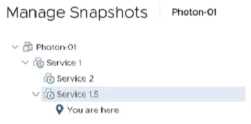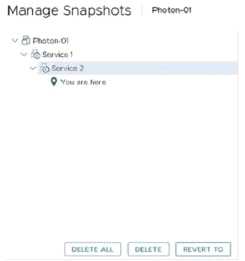VMware 1V0-21-20 Exam Questions
Questions for the 1V0-21-20 were updated on : Jul 02 ,2025
Page 1 out of 4. Viewing questions 1-15 out of 51
Question 1
Refer to the exhibit:
An administrator deletes the Service 1.5 snapshot.
What is the result of this action?
- A. Reversion to Service 1 snapshot, and Service 2 snapshot will remain.
- B. Reversion to Service 1 snapshot, and Service 2 snapshot will be deleted.
- C. Reversion to Service 2 snapshot, and Service 1 snapshot will be deleted.
- D. Deletion of all snapshots.
Answer:
A
Question 2
Which hypetvisor is a type-1 hypervisor?
- A. Oracle VM VirtualBox
- B. VMware ESXi
- C. VMware Fusion
- D. VMware Workstation
Answer:
B
Question 3
A system administrator is preparing a host In a vSphere DRS cluster in partially automated mode for
firmware patching and puts a host into maintenance mode. After several minutes, the host still has
not entered maintenance mode.
How should the system administrator resolve this problem?
- A. The system administrator needs to schedule DRS to run again.
- B. vSphere Lifecycle Manager and DRS integration need to be configured.
- C. vSphere HA admission control needs to be enabled on the cluster.
- D. The system administrator needs to migrate virtual machines using vSphere vMotion.
Answer:
D
Question 4
Which IP storage is supported on vSphere?
- A. SCSI
- B. vSAN
- C. SAN
- D. ISCSI
Answer:
D
Question 5
Which vSphere feature protects against host hardware failures by restarting virtual machines (VMs)
on hosts that are running in the cluster?
- A. vSphere HA
- B. vSphere vMotion
- C. vSphere Fault Tolerance
- D. vSphere DRS
Answer:
A
Question 6
An administrator must ensure that virtual machines have their initial placement performed
automatically and that migration recommendations are displayed but not applied.
Which vSphere DRS Automation Level should the administrator use?
- A. Aggressive
- B. Manual
- C. Partially Automated
- D. Fully Automated
Answer:
C
Question 7
An administrator is trying to configure EVC on a cluster that has both AMD and Intel hosts, but the
configuration is failing. What is causing this failure?
- A. The administrator did not separate out the hosts by processor type prior to enabling EVC.
- B. The administrator did not configure vMotion on all hosts prior to enabling EVC.
- C. The administrator did not remove all passthrough devices prior to enabling EVC.
- D. The administrator did not configure vSphere HA prior to enabling EVC.
Answer:
A
Question 8
Which DRS score indicates that the virtual machine (VM) is experiencing severe resource contention?
- A. 50%
- B. 95%
- C. 70%
- D. 15%
Answer:
D
Question 9
An administrator is working on a cloud migration project. The project has a requirement to check the
EVC mode for virtual machines (VMs) hosting an application.
How can the administrator find the FVC details for these VMs?
- A. Select Host > VMs > Show/Hide Column > EVC Mode
- B. Right click VM > Migrate > Change storage only > Select Datastore > Next > Finish
- C. Power off VM > Configure > VMware EVC
- D. Right click VM > Migrate > Change compute resource only > Select Host > Next > Finish
Answer:
D
Question 10
Which configuration setting prevents a packet sniffing program from analyzing network packets on
the virtual switch?
- A. Promiscuous Mode set to Reject
- B. Promiscuous Mode set to Accept
- C. Forged Transmits set to Accept
- D. Forged Transmits set to Reject
Answer:
A
Question 11
What is the default encrypted vSphere vMotion state for virtual machines that are not encrypted?
- A. Disabled
- B. Required
- C. Opportunistic
- D. Enabled
Answer:
C
Question 12
A group of VMs is experiencing high latency on a portgroup in an ESXi host.
Which option can a vSphete administrator use to move some of the VMs to another portgroup?
- A. IP hash
- B. Network I/O Control
- C. vSphere vMotion
- D. Network Port Binding
Answer:
C
Question 13
An administrator has applied a Service 2 patch after taking a snapshot. The administrator then
realizes that a Service 1.5 patch should have been applied before the Service 2 patch.
Refer to the exhibit:
Which series of actions should be taken to manage this issue?
- A. Delete all the snapshots, take a snapshot, and apply Service 1.5 patch.
- B. Remain at Service 2, take a snapshot, and apply Service 1.5 patch.
- C. Delete Service 1, take a snapshot, and apply Service 1.5 patch.
- D. Revert to Service 1, take a snapshot, and apply Service 1.5 patch.
Answer:
D
Question 14
On a vSphere Standard Switch, which setting should an administrator configure to improve the
networking efficiency by increasing the amount of payload data transmitted with a single packet?
- A. VLAN
- B. LACP
- C. MTU (Bytes)
- D. NIC Teaming
Answer:
C
Question 15
A vSphere administrator sees the alarm:
vSphere HA virtual machine failed to failover
This occurred for virtual machines (VMs) in a cluster with vSphere High Availability (HA) enabled. The
guest operating system on the VMs did not report a power failure.
What is a possible cause of this event?
- A. The host is still running but has disconnected from the network.
- B. The VMs cloning operations did not complete.
- C. A reboot of vCenter Server impacted vSphere HA.
- D. The VMs encountered an error during migration using vSphere vMotion.
Answer:
A